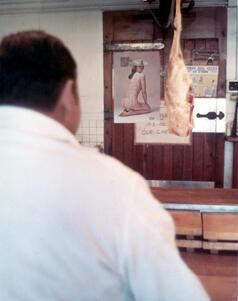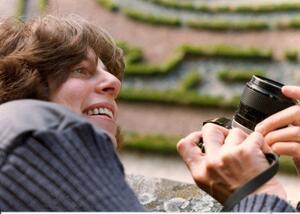Diana Mara Henry
The third image, from a color negative, is a photograph taken in Boston’s North End, in 1968. I was 19, a Junior at Radcliffe, and becoming known as a photographer as a result of my work for the Harvard Crimson. I believe this is my first “feminist” image, and possibly I have made none stronger. In it, we the viewers look over a white-coated butcher’s massive shoulder and follow his gaze to a poster, depicting a long-haired woman, nude except for a man’s hat, and inscribed with lines like a cow with the “cuts” indicated by lines drawn on her skin. A quarter of a beef carcass hangs next to the poster, in ominous reference to what could be done to her with a butcher’s chainsaw.
I doubt if the poster is still in production today. It is my best fantasy that the butcher was looking at it for the last time, and that, in that moment of my taking the photo and his seeing it through my young and innocent eyes, the monstrous world of male chauvinism began to crumble.
The second image is from the first time I saw Bella Abzug. I heard on the radio that she would be holding a press conference at the Battery to protest redistricting of Congressional districts on Manhattan's West Side. I elbowed my way into the circle of TV and radio reporters and crouched at her feet to get the photos. I was so excited by her magnetism and the intensity of her delivery, but especially by the power of the images I was capturing, that I dropped my lens as I was changing to a wide angle. Another of my photos from this shoot was used for a poster of Bella in her next Congressional race, under the heading: "Choose Action, Choose Bella." She won the election, and thus began a collaboration that culminated – but did not end – with her hiring me to be the official photographer for the First National Women's Conference, Houston, 1977.
The first image depicts the last mile of the torch relay, Seneca Falls to Houston, November 1977. I was rushing backward as fast as I could in order to get the shot of these proud and happy women energetically marching to the Houston convention center where the First National Women’s Conference was about to begin. Bella was the Chief Presiding Officer of the President's Commission on International Women's Year and of the conference. The young women holding aloft the torch that had been carried in a relay of thousands of people along the way from Seneca Falls, NY, where the first women's rights convention was held under the guidance of Susan B. Anthony, were Houston-area athletes Sylvia Ortiz, Peggy Kokernot, and Michele Cearcy. Only the blond Peggy Kokernot was featured on the cover of Newsweek. Betty Friedan is on the right, Susan B. Anthony, great-great-grandniece of the original suffragist by that name, and Billie Jean King, tennis champion, are on the left, with a champion swimmer at far left whose name I do not know. This is my most famous photograph, with a distinguished publication history and a future secure as long as some people prize human freedom.
Diana Mara Henry has spent her professional life documenting heroic individuals and milestone events on the cutting edge of social change, using photography and the written word to communicate values of freedom and dignity for all living beings. She began her career in journalism at the Harvard Crimson, then worked at NBC News and Newhouse newspapers before going freelance. She was the official photographer for the First National Women's Conference, Houston, 1977. Henry is the recipient of grants from the New York State Council on the Arts and the New York Foundation for the Arts and has taught photography at the International Center of Photography in New York City and in other locations. Henry has exhibited at the Women's Hall of Fame, The Overseas Press Club in New York City, The Schlesinger Library on the History of Women in America and many other venues; and now publishes and exhibits her photographs on line through her website, dianamarahenry.com. With the help of the MS Foundation for Women, the official report of the Conference, The Spirit of Houston, which includes 85 of Henry's official photographs, has been reprinted for the first time since 1978. Thanks to the Vermont Arts Council, her new website, spiritofhouston.net, brings the living history of the conference into the spotlight again.






